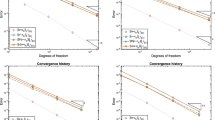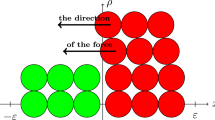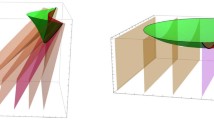Abstract
This paper is concerned with the dynamics for the compressible Navier–Stokes equations with density-dependent viscosity in bounded annular domains in \(R^{3}\). In the paper, we shall analyze the spherical symmetric model and establish the regularity in \(H^{2}\) and \(H^{4}\) under certain assumptions imposed on the initial data.
Similar content being viewed by others
1 Introduction
It is well known that the compressible isentropic Navier–Stokes equations which describe the motion of compressible fluids can be written in Eulerian coordinates as
where \(\rho ({\mathbf{x}},t)\), \({\mathbf{U}}({\mathbf{x}},t)\) and \(P(\rho )=\rho^{\gamma }\) (\(\gamma >1\)) stand for the fluid density, velocity and pressure, respectively, and the strain tensor is given by
The Lamé viscosity coefficients \(\mu (\rho )\), \(\lambda (\rho )\) satisfy the natural restrictions
For simplicity of the presentation, we consider only the viscosity terms \(\mu (\rho )=\rho \), \(\lambda (\rho )=0\) and \(D({\mathbf{U}})=\nabla {\mathbf{U}}\). Then (1.1)–(1.2) become
We are concerned with the spherically symmetric solutions of system (1.5)–(1.6) in bounded annular domains \(G=\{{\mathbf{x}} \in R^{3}, 0< a< \vert {\mathbf{x}} \vert <b<+\infty \}\). To this end, we denote
which leads to the following system of equations for \(r>0\):
We shall consider problem (1.8)–(1.9) in the region G subject to the initial data
and the boundary condition
First we find it convenient to transfer problems (1.8)–(1.11) into that in Lagrangian coordinates and draw the desired results. We introduce the following coordinate transformation:
then the boundaries \(r=a\) and \(r=b\) become
where \(\int_{a}^{b}\rho_{0}(s)s^{2}\,ds\) is the total initial mass and, without loss of generality, we can normalize it to 1. So in terms of Lagrangian coordinates, the domain G becomes \(\Omega =(0,1)\). The relations between Lagrangian and Eulerian coordinates are satisfied by
The initial boundary value problem (1.8)–(1.11) are changed to
Much progress was achieved recently on the compressible Navier–Stokes equations with density-dependent viscosity coefficient. Firstly let us recall some well-known results as regards the one-dimensional compressible isentropic Navier–Stokes equations with the flow density being connected with the infinite vacuum, [19, 24, 25] for the local well-posedness and the global existence of weak solutions to an initial boundary value problem with the viscous gas being connected vacuum states with jump discontinuities, [9, 10] for the global behavior with the initial density being piecewise smooth; [28–31, 34] for the local existence, the global existence, the asymptotic behavior and the uniqueness of weak solutions with a viscous gas being connected vacuum states with continuous density.
In spatial multi-dimension, there is a huge literature as regards the global existence, the regularity and the asymptotic behavior of a solution to system (1.1)–(1.2) with constant viscosity, we refer the reader to [2, 3, 11–14, 16, 20–23, 33] and the references therein. For the 3-D flow of a compressible fluid with cylindrical symmetry, the global existence and the large-time behavior of generalized solutions have been proved in [1, 4, 5, 7, 15, 23, 26, 27, 32] for the isentropic and the nonisentropic cases. The corresponding study of the regularity of a solution for any given initial datum has been carried out in [17]. For the 3-D flow of compressible fluid with spherical symmetry, there are some interesting results, [18] for the global well-posedness of classical solutions with large oscillations and vacuum; [33] for the global existence and uniqueness of the weak solution without a solid core; [14] for the structure of the solution; [21] for the global existence of the exterior problem and the initial boundary value problem. Besides, we would like to refer to [6, 8] as regards the existence and regularity of solutions for micropolar fluid with spherical symmetry in the three-dimensional case.
In the paper, we shall analyze the spherical symmetric model and focus on the initial boundary problem of an isentropic compressible fluid. We show the regularity in \(H^{2}\) and \(H^{4}\) under certain assumptions imposed on the initial data.
The notation in this paper will be as follows:
-
\(L^{p}\), \(1\leq p\leq +\infty \), \(W^{m,p}\), \(m\in N\), \(H^{1}=W^{1,2}\), \(H_{0} ^{1}=W_{0}^{1,2}\) denote the usual (Sobolev) spaces on \([0, 1]\). To denote various constants, we use \(C_{i}\) (\(i=1,2,4\)) to denote the generic positive constant depending only on the \(H^{i}\) norm of initial datum \((\rho_{0},u_{0})\), \({\min_{x\in [0,1]}\rho_{0}(x)}\) and variable t, respectively. In addition, \(\Vert \cdot \Vert \) denotes the norm in the space \(L^{2}\).
The basic assumption of this paper is the following:
for some constant \(\underline{\rho }>0\).
Theorem 1.1
Let \(\gamma >1\). Assume that the initial data \((\rho_{0},u_{0})\in H ^{2}(\Omega )\times H^{2}(\Omega )\) and (1.19) hold, then there exists a unique generalized global solution \((\rho (t),u(t))\in (H ^{2}(\Omega ))^{2}\) to the problem (1.15)–(1.18) verifying that, for any \(T>0\),
Theorem 1.2
Let \(\gamma >1\). Assume that the initial data satisfies (1.19) and \((\rho_{0},u_{0})\in H^{4}(\Omega )\times H^{4}(\Omega )\), then there exists a unique generalized global solution \((\rho (t),u(t))\in (H ^{4}(\Omega ))^{2}\) to the problem (1.15)–(1.18) verifying that, for any \(T>0\),
Corollary 1.1
Under assumptions of Theorem 1.2, (1.23)–(1.24) imply \((\rho (t),u(t))\) is the classical solution verifying that, for any \(t>0\),
2 Proof of Theorem 1.1
This section is devoted to deriving the estimates of the solutions to prove Theorem 1.1 which will be presented in a sequence of lemmas. We begin with the following lemma.
Lemma 2.1
(Theorem 2.2 in [21])
Under the assumptions in Theorem 1.1, then there exist positive constants \(\rho_{*}>0\) and \(\rho^{*}>0\) so that the unique global solution \((\rho (t),u(t))\) to problem (1.15)–(1.18) exists and satisfies, for any \(T>0\),
where \(\bar{\rho }=\frac{1}{b-a}\int_{a}^{b}\rho (s,t)s^{2}\,ds\).
Lemma 2.2
Under the conditions in Theorem 1.1, for any \(T>0\),
Proof
We infer from (1.16) that
Multiplying (2.5) by \(u_{xx}\) in \(L^{2}(\Omega )\), we deduce
Using Young’s inequality, Sobolev’s embedding theorem, and Lemma 2.1, we deduce from (2.6) that
whence
Differentiating (1.16) with respect to x, and exploiting (1.15), we have
which gives
with
Multiplying (2.9) by \(\rho_{xx}\), integrating the resultant over \([0,1]\), we deduce
Using the Young inequality and the interpolation inequality to the above inequality, then we get
Integrating (2.10) with respect to t, using initial condition \(\rho_{0}\in H^{2}\) and Lemma 2.1, we have
Then using the Gronwall inequality to the above inequality, we can get (2.3).
Differentiating (1.16) with respect to x, we can obtain
Integrating (2.11) over x and t, applying the embedding theorem, Lemma 2.1, (2.7) and (2.3), we conclude, for any \(t\in [0,T]\),
which, along with (2.7), gives (2.4). The proof is complete. □
Proof of Theorem 1.1
Clearly, (1.20)–(1.22) follow from Lemmas 2.1–2.2. This completes the proof of Theorem 1.1. □
3 Proof of Theorem 1.2
In this section, we shall complete the proof of Theorem 1.2. To this end, we assume that in this section that all assumptions in Theorem 1.2 hold. We begin with the following lemma.
Lemma 3.1
The following estimate holds for any \(T>0\):
Proof
We easily infer from (1.16) and (2.1)–(2.4) that
Differentiating (1.16) with respect to x and using Lemmas 2.1–2.2, we have
or
Differentiating (1.16) with respect to x twice and using the Cauchy–Schwarz inequality, we have
After differentiating (1.16) with respect to t, using (3.2)–(3.3) and (3.5), we can get
Now differentiating (1.16) with respect to t twice, multiplying the resulting equation by \((\frac{u}{r^{2}})_{tt}\) in \(L^{2}(\Omega )\), and using integration by parts and (1.18), we conclude
We use (2.1)–(2.4), (3.2)–(3.8), (1.16) and the interpolation inequality to deduce that, for any small \(\varepsilon \in (0,1)\),
Integrating (3.9) with respect to t, and using (2.1)–(2.4), initial condition (1.16) and (3.10)–(3.11), then we obtain (3.1). □
Lemma 3.2
For any \(T>0\) and \(\varepsilon \in (0,1)\), the following estimate holds:
Proof
Differentiating (1.16) with respect to t and x, then multiplying the resultant by \((\frac{u}{r^{2}})_{tx}\) in \(L^{2}[0,1]\), and integrating by parts, we know that
where
Now using Young’s inequality several times, and employing (2.1)–(2.4) and the interpolation inequality, after some calculation, we have, for any \(\varepsilon \in (0,1)\),
Differentiating (1.16) with respect to x and t, and using Lemmas 2.1–2.2 and (3.7)–(3.8), we conclude
We integrate (3.13) with respect to t, use (3.3), (3.14)–(3.16) and Lemmas 2.1–2.2 to obtain (3.12). The proof is complete. □
Lemma 3.3
The following estimates hold for any \(T>0\):
Proof
We insert (3.1) into (3.12) and pick ε small enough to get (3.18).
Differentiating (2.9) with respect to x, we have
where
Taking into account estimate (3.18), from (2.1)–(2.4) we can get
which, along with Lemmas 2.1–2.2 and (3.18), implies
After multiplying (3.20) by \(\rho_{xxx}\) in \(L^{2}[0,1]\), we deduce
which implies
Integrating (3.23) with respect to t, using (3.21), we conclude
which, after applying the Gronwall inequality and (3.22), yields
By (3.4), (3.6), (3.18) and Lemmas 2.1–2.2, we conclude
which, along with (3.24), gives (3.19). The proof is complete. □
Lemma 3.4
The following estimates hold for any \(T>0\):
Proof
Differentiating (1.16) with respect to t, and using Lemmas 2.1–2.2 and Lemma 3.3, we can get
Differentiating (3.20) with respect to x, we have
where
and
An easy calculation with the interpolation inequality, (3.2)–(3.8) and Lemmas 2.1–2.2 and Lemma 3.3 gives
Taking into account estimate (3.30)–(3.32), from (3.29), we obtain
Inserting (3.17) into (3.33), and integrating (3.33) with respect to t, using Lemmas 2.1–2.2 and Lemma 3.3, we have
Multiplying (3.28) by \(\rho_{xxxx}\) in \(L^{2}[0,1]\), we can get
which implies
Integrating (3.36) with respect to t, using (3.34), we conclude
which, after using Gronwall’s inequality, yields
Thus, we can obtain (3.25) by virtue of (3.37)–(3.38).
By (3.6), (3.17), (3.25), Lemmas 2.1–2.2 and Lemma 3.3, we have
On the other hand, we differentiate (1.16) with respect to x three times, use Lemmas 2.1–2.2 and (3.25), (3.27) to conclude, for any \(t\in [0,T]\),
Thus we deduce from (3.38)–(3.40) that
which, along with (3.39), gives (3.26). This completes the proof of the lemma. □
Proof of Theorem 1.2
Applying Lemmas 2.1–2.2 and Lemmas 3.1–3.4, we readily get estimates (1.23)–(1.26). This completes the proof of Theorem 1.2. □
4 Conclusions
In this paper, we have established the regularity of global solutions for the spherically symmetric compressible fluid with density-dependent viscosity in \(H_{2}\) and \(H_{4}\). The biggest difference from other papers is that our domain has spherical symmetry and the viscosity coefficients are density dependent.
References
Aoyama, R., Kagei, Y.: Large time behavior of solutions to the compressible Navier–Stokes equations around a parallel flow in a cylindrical domain. Nonlinear Anal. 127, 362–396 (2015)
Bresch, D., Desjardins, B.: Existence of global weak solutions for a 2D viscous shallow water equations and convergence to the quasi-geostrophic model. Commun. Math. Phys. 238, 211–223 (2003)
Bresch, D., Desjardins, B.: On the construction of approximate solutions for the 2D viscous shallow water model and for compressible Navier–Stokes models. J. Math. Pures Appl. 86, 362–368 (2006)
Cui, H., Yao, Z.: Asymptotic behavior of compressible p-th power Newtonian fluid with large initial data. J. Differ. Equ. 258, 919–953 (2015)
Dražić, I.: 3-D flow of a compressible viscous micropolar fluid with cylindrical symmetry: a global existence theorem. Math. Methods Appl. Sci. 40, 4785–4801 (2017)
Dražić, I., Mujaković, N.: 3-D flow of a compressible viscous micropolar fluid with spherical symmetry: a local existence theorem. Bound. Value Probl. 2012, 69 (2012)
Dražić, I., Mujaković, N., Črnjarić-Žic, N.: Three-dimensional compressible viscous micropolar fluid with cylindrical symmetry: derivation of the model and a numerical solution. Math. Comput. Simul. 140, 107–124 (2017)
Dražić, I., Simčić, L., Mujaković, N.: 3-D flow of a compressible viscous micropolar fluid with spherical symmetry: regularity of the solution. J. Math. Anal. Appl. 438(1), 162–183 (2016)
Fang, D., Zhang, T.: Global solutions of the Navier–Stokes equations for compressible flow with density-dependent viscosity and discontinuous initial data. J. Differ. Equ. 222, 63–94 (2006)
Fang, D., Zhang, T.: Discontinuous solutions of the compressible Navier–Stokes equations with degenerate viscosity coefficient and vacuum. J. Math. Anal. Appl. 318, 224–245 (2006)
Feireisl, E.: Dynamics of Viscous Compressible Fluids. Oxford University Press, Oxford (2004)
Frid, H., Shelukhin, V.: Boundary layers for the Navier–Stokes equations of compressible fluids. Commun. Math. Phys. 208, 309–330 (1999)
Frid, H., Shelukhin, V.V.: Vanishing shear viscosity in the equations of compressible fluids for the flows with the cylinder symmetry. SIAM J. Math. Anal. 31, 1144–1156 (2000)
Guo, Z., Li, H., Xin, Z.: Lagrange structure and dynamics for solutions to the spherically symmetric compressible Navier–Stokes equations. Commun. Math. Phys. 209, 371–412 (2012)
Huang, L., Dražić, I.: Large-time behavior of solutions to the 3-D flow of a compressible viscous micropolar fluid with cylindrical symmetry. Math. Methods Appl. Sci. To appear
Huang, L., Lian, R.: Exponential stability of spherically symmetric solutions for compressible viscous micropolar fluid. J. Math. Phys. 56, 071503 (2015)
Huang, L., Lian, R.: Regularity for compressible isentropic Navier–Stokes equations with cylinder symmetry. J. Inequal. Appl. 2016, 117 (2016)
Huang, X., Li, J., Xin, Z.: Global well-posedness of classical solutions with large oscillations and vacuum to the three-dimensional isentropic compressible Navier–Stokes equations. Commun. Pure Appl. Math. 65, 549–585 (2012)
Jiang, S., Xin, Z., Zhang, P.: Global weak solutions to 1D compressible isentropic Navier–Stokes equations with density-dependent viscosity. Methods Appl. Anal. 12, 239–252 (2005)
Jiang, S., Zhang, J.: Boundary layers for the Navier–Stokes equations of compressible heat-conducting flows with cylindrical symmetry. SIAM J. Math. Anal. 41, 237–268 (2009)
Lian, R., Huang, L., Liu, J.: Global solutions to the spherically symmetric compressible Navier–Stokes equations with density-dependent viscosity. J. Appl. Math. 2012, Article ID 395209 (2012)
Lions, P.L.: Mathematical Topics in Fluids Dynamics, Vol. 2. Compressible Models. Oxford Sci. Publ. Oxford University Press, Oxford (1996)
Liu, J., Lian, R.: Global existence of the cylindrically symmetric strong solution to compressible Navier–Stokes equations. Abstr. Appl. Anal. 2014, Article ID 728715 (2014)
Liu, T., Xin, Z., Yang, T.: Vacuum states of compressible flow. Discrete Contin. Dyn. Syst. 4, 1–32 (1998)
Okada, M., Matuss̆u-Necc̆asová, S̆., Makino, T.: Free boundary problem for the equation of one-dimensional motion of compressible gas with density-dependent viscosity. Ann. Univ. Ferrara, Sez. 7: Sci. Mat. 48, 1–20 (2002)
Qin, Y.: Exponential stability for the compressible Navier–Stokes equations with the cylinder symmetry in \(R^{3}\). Nonlinear Anal., Real World Appl. 11, 3590–3607 (2010)
Qin, Y., Jiang, L.: Global existence and exponential stability of solutions in \(H^{4}\) for the compressible Navier–Stokes equations with the cylinder symmetry. J. Differ. Equ. 249, 1353–1384 (2010)
Vong, S., Yang, T., Zhu, C.: Compressible Navier–Stokes equations with degenerate viscosity coefficient and vacuum (II). J. Differ. Equ. 192, 475–501 (2003)
Yang, T., Yao, Z., Zhu, C.: Compressible Navier–Stokes equations with density-dependent viscosity and vacuum. Commun. Partial Differ. Equ. 26, 965–981 (2001)
Yang, T., Zhao, H.: A vacuum problem for the one-dimensional compressible Navier–Stokes equations with density-dependent viscosity. J. Differ. Equ. 184, 163–184 (2002)
Yang, T., Zhu, C.: Compressible Navier–Stokes equations with degenerate viscosity coefficient and vacuum. Commun. Math. Phys. 230, 329–363 (2002)
Yao, L., Zhang, T., Zhu, C.: Boundary layers for compressible Navier–Stokes equations with density-dependent cylindrical symmetry. Ann. Inst. Henri Poincaré, Anal. Non Linéaire 28, 677–709 (2011)
Zhang, T., Fang, D.: Global behavior of spherically symmetric Navier–Stokes equations with density-dependent viscosity. J. Differ. Equ. 236, 293–341 (2007)
Zhu, C.: Asymptotic behavior of compressible Navier–Stokes equations with density-dependent viscosity and vacuum. Commun. Math. Phys. 293, 279–299 (2010)
Acknowledgements
The authors would like to thank the referees for their useful suggestions, which have significantly improved the paper.
Availability of data and materials
Data sharing not applicable to this article as no datasets were generated or analyzed during the current study.
Funding
This research was supported by the NSFC (No. 11501199) and the Natural Science Foundation of Henan Province (No. 18B110010).
Author information
Authors and Affiliations
Contributions
All authors carried out the proofs and conceived the study. All authors read and approved the final manuscript.
Corresponding author
Ethics declarations
Competing interests
The authors declare that they have no competing interests.
Additional information
Publisher’s Note
Springer Nature remains neutral with regard to jurisdictional claims in published maps and institutional affiliations.
Rights and permissions
Open Access This article is distributed under the terms of the Creative Commons Attribution 4.0 International License (http://creativecommons.org/licenses/by/4.0/), which permits unrestricted use, distribution, and reproduction in any medium, provided you give appropriate credit to the original author(s) and the source, provide a link to the Creative Commons license, and indicate if changes were made.
About this article
Cite this article
Huang, L., Lian, R. Regularity to the spherically symmetric compressible Navier–Stokes equations with density-dependent viscosity. Bound Value Probl 2018, 85 (2018). https://doi.org/10.1186/s13661-018-1007-x
Received:
Accepted:
Published:
DOI: https://doi.org/10.1186/s13661-018-1007-x




